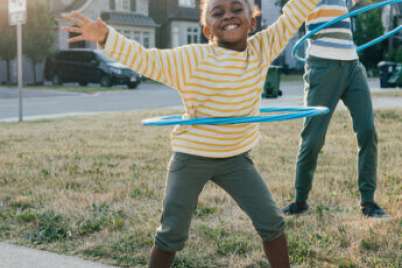
Making use of loose parts
Editor’s note: This article was updated on Sept. 27, 2019.
Close your eyes and imagine what a simple stick on the forest floor can become:
- A fishing rod?
- A whisk?
- A jump for a horse?
A stick, or any material that can be moved and manipulated, is considered “loose parts,” a term introduced in 1971 by the architect Simon Nicholson and adapted in modern early childhood education.
Unlike traditional parks and playgrounds in which the structure and environment are static, loose parts engage children’s natural creativity and encourage them to invent, problem solve, and construct the world around them. Natural environments like forests and beaches often provide significantly more loose parts than man-made structures, and a simple stick, as mentioned above, offers limitless possibilities.
In any environment, both the degree of inventiveness and creativity and the possibility of discovery, are directly proportional to the number and kind of variables in it.”
–Simon Nicholson
How to get started
The simplest way to play with loose parts is to get outside! Nature provides an abundant supply of materials for each of the senses to explore free of charge. Start your collection with sticks, pinecones, rocks, seashells, acorns, bark, and fallen leaves. Note: only take what is available on the forest floor or trail.
Next, gather everyday items in bulk to add to your loose parts supply. Ideas include:
- Tubes made from cardboard, concrete forms, plastic piping, dowels, stakes, or old playground slides
- Wheels like tires and inner tubes, bicycle wheels, or wire spools (from the small ones your electrician might purchase, up to the larger ones that electrical utility companies use)
- Rope of various weights; string, duct tape and nails, pegs, fishing nets, heavy netting, fabric and carpets (landscape fabric also works to keep small pieces from getting lost in the grass)
- Cardboard boxes, suitcases, or heavy duty stackable crates
- Wood, both planks (for see-saws and ramps) and smaller wood pieces (for stacking or construction)
- Costume pieces like hats, capes, goofy glasses and other accessories, or items like garbage pail lids (they make great superhero shields!)
- Electronics and keyboards because these are usually off-limits to kids and they love to disassemble them and reconfigure them into things like robots
- Kitchen items for a mud or dry kitchen centre could include a bowl or basin for a sink, as well as rolling pins, sieves, cookie cutters and moulds, muffin tins, and metal dishes (bowls, platters, trays, pitchers)
- Tools like scissors, hammers, mallets, or even saws (depending on the age of the children, of course)
- Natural pieces such as wicker baskets, large bark mulch, tree slices, tree stumps, pebbles, cones
Growing your loose parts collection doesn’t have to be costly. Engaging your community, nearby businesses, and online parent networks is an environmentally responsible way of collecting and reflecting the local culture. Even recycled materials make for imaginative play. Items like corks, lids, paper towel rolls, and bottle caps enhance a collection.
If you’re worried about the mess that loose parts can leave, use various containers to organize and store materials. Recycled egg cartons, ice cube trays, and utensil holders double as storage and sorting bins. Plus, rotating loose parts in and out of play keeps children interested without becoming overwhelmed by choice.
How to use loose parts
This is where the fun begins! With loose parts, children have the freedom to choose what each item will be and how it will function, developing skills as they play. The role of the adult is to observe and reflect with the child, following their lead and ensuring their safety. Preparing and organizing a variety of appealing spaces for children to explore loose parts sparks their interest and enhances their experience. For a great introduction to the facilitation and benefits of loose parts play, visit your local early-years centre.
Why loose parts?
There are many studied benefits of playing with loose parts, including:
- increased physical activity
- more symbolic and imaginative play
- improved cooperation and communication with others
- problem-solving and mathematical thinking
- emotional advantages of playing in nature
Not to mention, the affordable advantages of loose parts over modern toys. Now think back to the simple stick on the forest floor. Inspired yet? Share with us your collection of loose parts and how you’re playing today.
For more, this resource provides a detailed description and toolkit regarding loose parts.
Photo: Jeff Higgins






Loose parts are a welcome addition to our programs and our homes. Although there is a bit of push back in the beginning sitting and watching the creativity and openness to play has been a blessing.
The parents involved in our programs also say it reminds them of their childhood!
In my son’s school and another nearby school here in Toronto the primary things the children do with loose parts is horde, steal from each other and hit each other with the loose parts. They’ve had to take away much of it to cut down on injury! A failed program!
Too bad! Obviously the children love the loose parts and that is why they are hoarding, stealing etc.. They need the adults in their life to understand this and help them appreciate the loose parts. It’s part of their learning!! Taking the loose parts away teaches them absolutely nothing and their learning is stifled. In this scenario the adults are the problem and needs more training on the life skills that can be learned through loose parts!